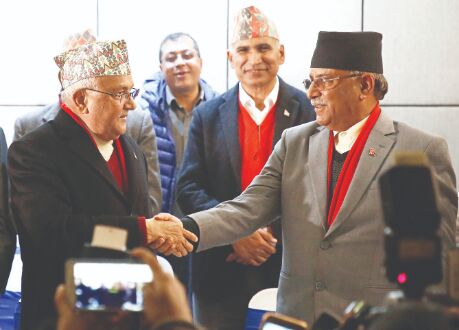Breakdown
As India and China watch closely, ideological differences in the ruling CPN party push Nepal further into a political crisis — one that may favour the opposing Nepali Congress

The continuing feud between two factions of the Nepal Communist Party (CPN), one led by Prime Minister K, P. Sharma Oli and the other led by party chairman Pushpa Kamal Dahal, better known as Prachanda, has landed Nepal in a first-class political crisis. Oli had been losing support in his party till he lost the majority not only in the party but in the Parliament as well. But instead of resigning as Prime Minister, he approached the President, Vidya Devi Bhandari last Sunday and persuaded her to sign a presidential decree dissolving the Parliament (the House of the People).
General elections were scheduled to be held in 2022 but after the dissolution of Parliament elections have been advanced. Now the elections will be held between April 30 and May 10 next year.
It was known for a long time that there was no love lost between Oli and Prachanda. Recently, Prachanda and another top party leader, Madhav Kumar Nepal, had demanded Oli's resignation both as Prime Minister and as co-chairman of the CPN. Oli had accused Prachanda and his colleagues of "conspiring" to topple his government and hinted that India had a complicit role in it. Oli made no secret of his intention to split the party. He also refused to convene a meeting of the Central Secretariat of the party to resolve contentious issues as requested by Prachanda. It was clear that a parting of ways between the two factions had become inevitable.
Oli has been demonstrably pro-China and anti-India. It was he who embittered the relationship between India and Nepal by unilaterally re-drawing Nepal's map showing Indian territories of Lipulekh, Kalapani and Limpiyadhura as Nepali territory and post-haste got the new map approved by Nepal Parliament. Many believe that there was a Chinese hand behind Nepal's cartographic war against India. China has been directly interfering in the internal politics of Nepal.
Hou Yanqi, the Chinese ambassador has been openly trying to broker a peace between the two factions of the NCP, throwing to the winds all diplomatic propriety and protocol. But she failed in her mission. Prachanda has been critical of Prime Minister Oli for a number of his policies, including his policy toward India and the manifestly pro-China tilt in his foreign policy. Prachanda is against unnecessarily antagonizing India. He wants a nuanced policy to Nepal's two big neighbours, India and China.
A bitter politico-ideological war is being waged by the two factions of the NCP. A full meeting of the party's Central Committee could not be held for a long time because of the raging political feud within the party. At one stage it was decided that the Prime Minister would have a free hand in the day-to-day running of the Government, while Prachanda will be in executive control of the party and run the party as per the recommendation of the six-member task force. But Matrika Prasad Yadav, a member of the party's Standing Committee, insisted that the feud within the party was about ideology and policies and not about "who gets what position" in the party. So the politico-ideological war in the party, which many believe is an extension of the personal incompatibility of Oli and Prachanda, has brought the Nepal Communist Party on the verge of a split and landed the country in political turmoil.
Meanwhile, Oli's controversial decision to dissolve Parliament has been challenged before the Supreme Court of Nepal. Seven ministers in his government have also resigned calling the dissolution a "constitutional coup" because it violates the popular mandate given to him in the last general elections. The three petitions challenging the dissolution are being registered, according to the apex court spokesman Bhadrakali Pokharel.
The root of the factional war in the CPN has to be found in the process of formation of the party. Before its formation on May 17, 2015, there were two communist parties; one the Communist Party of Nepal (Unified Marxist-Leninist), while the other was the Communist Party of Nepal (Maoist Centre). Before the merger, they were at daggers drawn. There used to be frequent armed clashes between the two, sometimes ending in fatalities.
The multiplicity of political parties in Nepal and their disunity delayed the adoption of a constitution for the country after the monarchy was abolished as there was no stable government that could pass a constitution. In the interest of giving a stable government, the two CPs decided to unite but, as subsequent events have proved, their ideological differences and differing perceptions of current problems persisted even after the formal unity. This has now come into the open.
It is doubtful if the coming elections will be able to usher in a stable government. The people are fed up with the internecine quarrels of the two factions of the CPN. As things stand, they will be at each other's throat during the poll campaign. In the dissolved House, the CPN had 174 MPs while the Nepali Congress had 67. It remains to be seen whether this time the Nepali Congress can get wider support from the people who are disgusted with the endless feuding in the CPN. It may be recalled that the Nepali Congress fully supported the new map of Nepal prepared by the Oli Government, showing three regions of India as Nepal territory.
India and China will, of course, keenly watch the situation in Nepal and assess the prospects of the major parties, because Nepal has now become an important player in South-East Asian politics.
Views expressed are personal



